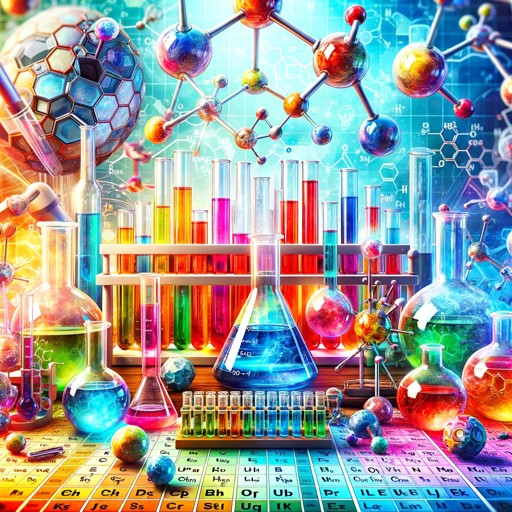AP Chemistry-AP Chemistry assistance tool
AI-powered Chemistry learning aid
How does molarity relate to concentration?
Step-by-step guide to balance chemical equations
Difference between endothermic and exothermic processes?
Effective study methods for AP Chemistry
Related Tools
Load More
Chemistry Chem
🔷#𝟏 𝐏𝐞𝐫𝐬𝐨𝐧𝐚𝐥𝐢𝐳𝐞𝐝 𝐂𝐡𝐞𝐦𝐢𝐬𝐭𝐫𝐲 𝐓𝐮𝐭𝐨𝐫🔷

Chemistry Tutor
Advanced & engaging chemistry tutor, tailored for students.

ChemistryGPT
Your go-to source for all things chemistry

chemistry
The world's most powerful chemistry tutor.

Advanced Physical Chemistry Tutor
Tutor for graduate-level physical chemistry.

Quimica General
Quimica general de universidad, creador de problemas, responde respuestas y ayuda a estudiar y entender mejor los temas
20.0 / 5 (200 votes)
Introduction to AP Chemistry
AP Chemistry is a comprehensive, college-level course designed to provide high school students with a thorough understanding of chemical principles and concepts. The course covers a wide range of topics including atomic structure, chemical bonding, thermodynamics, kinetics, equilibrium, and electrochemistry. AP Chemistry aims to develop students' problem-solving skills, laboratory techniques, and understanding of scientific practices. For instance, students might explore the periodic trends in the elements by analyzing their properties or conduct experiments to determine reaction rates and the effects of catalysts.

Main Functions of AP Chemistry
Instructional Content
Example
Detailed lessons on topics such as molecular geometry and gas laws.
Scenario
Students use this content to prepare for classroom discussions, complete homework assignments, and study for exams.
Laboratory Experiments
Example
Experiments to determine the empirical formula of a compound or the pH of various solutions.
Scenario
Students perform these experiments in a lab setting, analyze their data, and write lab reports to reinforce theoretical knowledge with practical experience.
Practice Exams and Quizzes
Example
Timed practice exams modeled after the AP Chemistry exam format.
Scenario
Students take these practice exams to familiarize themselves with the test format, identify areas for improvement, and build test-taking strategies.
Ideal Users of AP Chemistry
High School Students
Students enrolled in AP Chemistry who aim to earn college credit and prepare for STEM-related college majors benefit greatly from these resources. They gain a solid foundation in chemistry that is essential for advanced studies in fields such as chemical engineering, medicine, and environmental science.
Chemistry Teachers
High school chemistry teachers use AP Chemistry resources to enhance their curriculum, provide students with rigorous practice materials, and guide lab experiments. These resources help teachers align their teaching with AP standards and improve student outcomes on the AP exam.

Guidelines for Using AP Chemistry
Visit aichatonline.org
For a free trial without login, also no need for ChatGPT Plus.
Access Comprehensive Resources
Make sure you have the necessary textbooks and reference materials, such as Zumdahl and Zumdahl's AP Chemistry Textbook.
Utilize the Reference Tables
Keep the periodic table and equations/constants reference tables handy for quick lookup.
Practice with Exercises
Regularly complete practice problems and past exam papers to reinforce your understanding.
Engage in Labs and Experiments
Participate in laboratory exercises to apply theoretical knowledge practically and enhance learning.
Try other advanced and practical GPTs
Business Statistics Calculator
AI-Powered Business Statistics Solutions
Statistics Tutor with R, Python and SPSS
AI-powered insights for statistical analysis

Dating App Chat Expert
AI-Powered Dating App Chat Expert

SaaS Visionary
AI-Powered SaaS Project Ideation

のGPTs Generator - Provides automatic generation 😃
AI-powered customization for your needs

💜 내 남편을 찾아줘 !! 💜 Ver 4.7
Immerse in romance quests powered by AI.
AP English Essay Scorer
AI-Powered AP English Essay Scoring
AP PreCalc
AI-powered solutions for PreCalc success

2in1 RUS-ENG/ENG-RUS translator
AI-Driven Precision for Seamless Translation

Rechtschreibung / Grammatik Deutsch GER
AI-Powered German Grammar and Spelling Correction

Deutscher Textverbesserer
AI-powered German text improvement

GPT deutsches Vertrags- und Handelsrecht
AI-powered insights for German legal needs

- Problem Solving
- Exam Prep
- Homework Help
- Concept Review
- Lab Work
AP Chemistry: Detailed Q&A
What topics are covered in AP Chemistry?
AP Chemistry covers a wide range of topics including atomic structure, molecular and ionic compound structure, intermolecular forces, chemical reactions, kinetics, thermodynamics, equilibrium, acids and bases, and electrochemistry【23†source】.
How can I effectively prepare for the AP Chemistry exam?
Effective preparation involves a combination of studying the textbook, using the reference tables, practicing problems, participating in lab exercises, and taking practice exams to identify and work on weak areas【24†source】【25†source】.
What is the importance of the periodic table in AP Chemistry?
The periodic table is crucial for understanding the properties and behaviors of elements, predicting the outcomes of chemical reactions, and solving problems related to atomic structure and periodic trends【22†source】.
What resources are available for learning AP Chemistry?
Resources include textbooks like Zumdahl and Zumdahl's AP Chemistry, online platforms for practice problems, reference tables for equations and constants, and laboratory manuals for experimental exercises【23†source】【26†source】.
How does one calculate the equilibrium constant (K) from standard cell potential (E°cell)?
The equilibrium constant (K) can be calculated using the equation ΔG° = -RT ln K and the relationship ΔG° = -nFE°cell. By combining these equations, you can solve for K using the standard cell potential and other given values【25†source】.